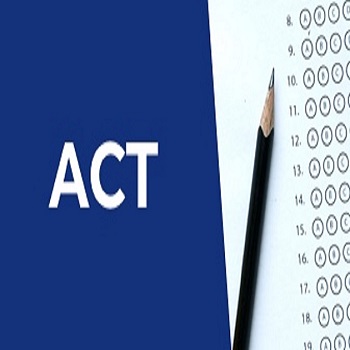The ACT is a standardized test that assesses a student’s skills in five core areas: English, Math, Reading, Science, and Writing (optional). Students of all 4 years from 9th -12th grade take the ACT so that they can submit their scores to colleges as part of the college application process. Usually, 11th and 12th-grade students take the ACT.
Exam Details
The following table gives you a good idea about the flow of the examination on the test day:
| ACT Section | # of Questions | Duration | Syllabus | Question Type |
| English | 75 | 45 minutes | Usage/mechanics and rhetorical skills | Multiple choice |
| Math | 60 | 60 minutes | Algebra, geometry, elementary trigonometry, reasoning, and problem-solving | Multiple choice |
| Reading | 40 | 35 minutes | Reading Comprehension | Multiple choice |
| Science | 40 | 35 minutes | Interpretation, analysis, evaluation, reasoning, and problem-solving | Multiple choice |
| Optional Writing Test | 1 essay prompt | 30 minutes | Writing Skills | Written |
ACT English
This section contains 5 passages for a total of 75 multiple-choice questions. The questions pertain to a particular paragraph or the whole passage, in terms of detail or overall idea/big picture. ACT English consists of two sections, Usage and Mechanics and the second is Rhetorical Skills. Usage and Mechanics require fine-tuned punctuation and grammar knowledge. Rhetorical Skills focus on your comprehension of the passage as a whole and your ability to maximize the passage’s organization and style.
Subsection 1: Distribution of questions in Usage/Mechanics
- Punctuation (10-15%)
- Grammar and usage (15-20%)
- Sentence structure (20-25%)
Subsection 2: Distribution of questions in Rhetorical Skills
- Organization (10-15%)
- Strategy (15-20%)
- Style (15-20%)
ACT Math
The ACT Math section is categorized into several topics. The distribution of questions topic-wise are as follows:
- Pre-Algebra: comprises of 20-25% of the total questions. It includes number problems, multiples/factors/primes, divisibility, percentages, fractions, square roots, ratios, mean/median/mode, probability, place values, absolute values, exponents, series, simple descriptive statistics.
- Elementary Algebra: comprises of 15-20% of the total questions. It includes substitution, simplifying expressions, solving linear equations, inequalities, multiplying binomials, solving quadratic equations.
- Intermediate Algebra: comprises of 15-20% of the total questions. It includes solving systems of equations, functions, matrices, logarithms, inequalities, sequences and patterns, complex numbers.
- Coordinate Geometry: comprises of 15-20% of the total questions. It includes number lines, graphing inequalities, distance and mid-points, slope calculation, parallel/perpendicular lines, line equation, conic sections.
- Plane Geometry: comprises of 20-25% of the total questions. It includes lines and angles, triangles, polygons, circles, 3-D geometry, volume, properties of circles, triangles, and parallelograms.
- Trigonometry: comprises of 5-10% of the total questions. It includes solving triangles, trigonometric identities and graphs, graphing trigonometric functions, solving trigonometric equations.
ACT Reading
The ACT Reading section divides the content into three major content buckets: Key Ideas and Details, Craft and Structure, and Integration of Knowledge and Ideas. This section contains 4 passages for a total of 40 multiple-choice questions. The passages will represent four broad areas: social science, humanities, natural science, and literary fiction.
Distribution of questions in Rhetorical Skills
- Integration of Knowledge (13-18%)
- Craft and Structure (25-30%)
- Key Ideas and Details (55-60%)
Skills Tested on ACT Reading
- Know main ideas
- Find details within a passage and interpret them
- Understand the sequence of events and flow of ideas
- Interpret cause-effect relationships
- Determine the synonyms, phrases, and statements in context
- Draw generalizations
- Make judgments
- Study the author’s or narrator’s tone and purpose
ACT Science
This section contains 7 passages for a total of 40 multiple-choice questions. Tables, charts, and graphs often accompany the passages. The topics that are tested revolve around Physics, Chemistry, Biology, and Earth Sciences. A wide range of science content, it tests your scientific skills more than your knowledge. As the ACT puts it, “the Science Test measures the interpretation, analysis, evaluation, reasoning, and problem-solving skills required in the natural sciences.
The distribution of questions in the Science section:
- Data Representation (30-40% of Questions)
- Research Summaries (45-55% of Questions)
- Conflicting Viewpoints (15-20% of Questions)
Writing (Optional)
The ACT emphasizes the cogency of an essay. You will earn a high grade if you can incorporate different lines of reasoning and weave them into a coherent written piece. Because of the time constraint, a polished first draft is expected rather than a perfect written sample.
The authors present 3 different viewpoints on a particular topic in a short passage. It’s your responsibility to analyze the viewpoints, explain their merits and weaknesses, identify flaws (if any), point out caveats, and compare one argument with the others.
Understanding the syllabus can help you prepare for tests and avoid nasty surprises on test days. Moreover, it will help you in preparing an optimal study plan based on your strengths and weaknesses in different subject areas.
Smart Strategy for ACT preparation test in a month download the ACT free e-Book.
Grade your ACT practice test bubble-sheet online to get a detailed Socrato diagnostic report.










